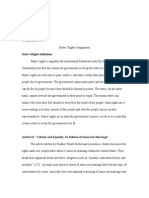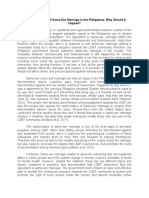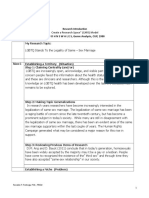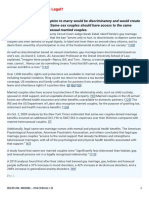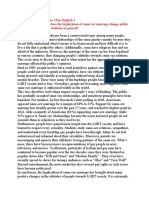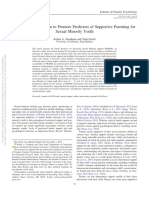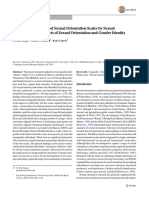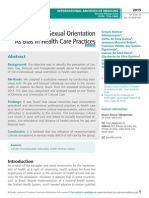RESEARCH
BRIEF
Legalizing Marriage
for Same-Sex Couples
Benefited LGBT Individuals
and Their Children
TWENT Y YEARS OF EVIDENCE
�KEY FINDINGS
■ Across 96 empirical studies conducted over the sexually transmitted infections and problematic
past 20 years, research has consistently found substance use.
that same-sex couples; lesbian, gay, bisexual, and ■ Legalizing marriage for same-sex couples led
transgender (LGBT) individuals; and their children to significant declines in suicide attempts among
have benefited from the granting of legal status to LGBT adolescents; declines in mental health
the marriages of same-sex couples. care visits and mental health care costs for
■ In contrast, research has not identified any sexual-minority men; and declines in perceived
reliable adverse consequences of granting discrimination and depressive symptoms for
same-sex couples access to legal marriage. sexual-minority women.
■ When states legalized marriage for same-sex ■ The availability of legal marriage for same-sex
couples, same-sex households in those states couples greatly reduces disparities in access
experienced more-stable relationships, higher to private health insurance between children
earnings, and higher rates of homeownership. of same-sex couples and children of different-
■ Married same-sex couples report greater positive sex couples. Differences in academic progress
mood, lower stress, fewer depressive symptoms, between the children of same-sex couples
and higher life satisfaction than unmarried same- and children of different-sex couples were also
sex couples, and these differences are more greatly reduced when states granted same-sex
consistent for married couples than for those in couples access to legal marriage and have
domestic partnerships or civil unions. disappeared entirely since 2010.
■ Marriage bans for same-sex couples had adverse
■ When states legalized marriage for same-sex
consequences. For example, LGBT residents of
couples, the physical health of LGBT individuals
states with marriage bans for same-sex couples
in those states also improved, demonstrated by
reported higher anxiety and lower life satisfaction
higher levels of health care use, higher levels of
than residents of states without bans.
health insurance coverage, and declining rates of
T
wo decades ago, the United States was
divided by heated debates over the merits
of legalizing marriage for same-sex couples.
Those who were in favor argued that grant-
ing same-sex couples access to marriage would
strengthen commitment for same-sex couples,
extend the financial benefits of marriage to same-
sex households, and improve outcomes for children
being raised by same-sex parents. Those who were
opposed argued that granting legal status to mar-
riages between same-sex partners would alter the
foundation of marriage and thereby diminish its value
for different-sex couples, ultimately harming children
by making them less likely to be raised in stable, two-
parent families. Twenty years have passed since the
first marriage licenses were issued to same-sex cou-
ples in Massachusetts in May 2004, making it pos-
sible to evaluate the evidence for these arguments.
Toward this goal, RAND researchers conducted
a review of existing evidence and new analyses to
identify the effects of granting legal status to the mar-
2
� riages of same-sex couples in the United States. This
research brief highlights the findings from the review
of studies addressing the effects of granting that
legal status on same-sex couples; their children; and
lesbian, gay, bisexual, and transgender (LGBT) indi-
viduals more generally. A companion research brief
highlights the effects of granting marriage rights to
same-sex couples on the general population.
To identify relevant studies, the research team
searched four independent databases (Web of Sci-
ence, Scopus, Social Sciences Abstracts, and Policy
File Index) for published work that examined the
effects of granting legal status to same-sex couples,
either in civil unions or in marriages, in the United
States. From the original search and after identify-
ing additional articles from research reviews and
citations, the team identified 96 relevant articles that
examined the effects of granting legal status to same-
sex couples on same-sex couples, their children, and Across all of these studies, the findings have been
the general population. As shown in Figure 1, research unambiguous and consistently positive. In nearly
on this topic began immediately after the first mar- every area that research has examined (see Figure 2),
riage licenses were issued to same-sex couples by same-sex couples, LGBT individuals, and their chil-
the state of Massachusetts in 2004, and scholarly dren and family members have benefited greatly from
interest expanded after the Supreme Court’s Oberge- the granting of legal status to the marriages of same-
fell v. Hodges decision legalized marriage for same- sex couples. The following sections review the docu-
sex couples nationwide in 2015. mented benefits to each of these groups.
FIGURE 1
Recent Literature Focuses on Impacts for LGBT Individuals
12
Number of studies published
10
0
2004 2005 2006 2007 2008 2009 2010 2011 2012 2013 2014 2015 2016 2017 2018 2019 2020 2021 2022 2023 2024
Children General population LGBT individuals
SOURCE: Features data from Benjamin R. Karney, Melanie A. Zaber, Molly G. Smith, Samuel J. Mann, Marwa AlFakhri, Jessie Coe, Jamie L. Ryan,
Catria Gadwah-Meaden, Christy Mallory, Brad Sears, and Chandra Garber, 20 Years of Legal Marriage for Same-Sex Couples in the United States:
Evidence Review and New Analyses, RAND Corporation, RR-A2912-1, 2024 (Appendix B, Table B.1).
NOTE: Studies covering multiple topics are listed multiple times.
3
�FIGURE 2
Literature on the Effects of Marriage Recognition Is Wide-Ranging
Psychological well-being
Public opiniona
Physical health
Couple well-being
Financial well-being
Trends in family formationa
Health insurance
Social connection
Employment
Children of same-sex parentsa
Public healtha
Economic trendsa
0 5 10 15 20 25 30
Number of articles
SOURCE: Features data from Karney et al., 2024 (Appendix B, Table B.1).
NOTE: Studies covering multiple topics are listed multiple times.
a
Topic focuses on the broader U.S. population (i.e., all U.S. residents).
Effects on Same-Sex Couples and ples alleviated some of that stress, leading to greater
psychological well-being among same-sex couples
LGBT Individuals
and LGBT individuals. Specifically, across 25 stud-
Same-sex couples and LGBT individuals are the pop- ies of this issue, married same-sex couples reported
ulations most directly affected by laws and policies greater positive mood, lower stress, fewer depressive
granting or withholding legal marriage for same-sex symptoms, and higher life satisfaction than unmar-
couples. Accordingly, the greatest impacts of policy ried same-sex couples, and these differences were
changes affecting the legal status of same-sex cou- more consistent for married couples than for those
ples have been observed in these populations. These in domestic partnerships or civil unions. In contrast,
impacts include benefits to psychological and emo- when states banned or proposed bans on marriage
tional well-being, physical health, insurance coverage, between same-sex partners, LGBT residents of those
and financial security and employment. states reported higher anxiety, stress, depression,
and negative mood and experienced increased rates
of multiple psychiatric disorders, compared with resi-
Psychological Well-Being
dents of states that were not considering or enacting
On average, when members of sexual- and gender- such bans. Prior to the Obergefell v. Hodges deci-
minority groups are subject to stigma and discrimi- sion in 2015, even already-married same-sex couples
nation, the stress of these experiences negatively experienced less negative affect when they resided
affects their mental health. By validating same-sex in states that recognized their marriages than when
relationships, legalizing marriage for same-sex cou-
4
�they resided in states that failed to recognize their dissolve than couples consisting of two men. Mar-
marriages. riage increases investment in the relationship, and
Repeated surveys and longitudinal analyses sug- married same-sex couples report greater relation-
gest that these effects are causally related to changes ship satisfaction and commitment than unmarried
in policy. For example, state-level rates of suicide same-sex couples do. Couples consisting of two
attempts among LGBT adolescents declined signifi- women take up marriage at higher rates than couples
cantly after states legalized marriage for same-sex consisting of two men and are more likely to increase
couples, even after controlling for other differences specialization of household and caregiving labor in
among states. In Massachusetts, mental health care response to relationship recognition policies.
visits and mental health care costs for sexual-minority
men declined significantly after legalization. Research
following sexual-minority women from 2000 to 2012
Physical Health
found that perceived discrimination and depressive Relative to heterosexual and cisgender individuals,
symptoms declined after legal rights were extended LGBT individuals have been shown to experience
to same-sex couples, especially among women with increased risk for several physical illnesses, including
less education and women who were sexual and cancer and cardiovascular conditions, often as con-
racial minorities. sequences of stress caused by repeated experiences
of stigma and prejudice. In different-sex couples,
however, satisfying marriages have been consistently
Couple Well-Being linked to greater physical heath and lower mortality.
Among different-sex couples, marriage decreases the Over the past 20 years, 16 studies have shown that
risk of relationship dissolution, promotes investment the health benefits associated with marriage apply
in the relationship, and is associated with higher rela- to same-sex couples as well, offsetting many of the
tionship quality compared with cohabitation. Thirteen health disparities LGBT individuals might otherwise
studies addressing the effects of marriage on same- face.
sex couples found that, when same-sex couples were For example, LGBT individuals in same-sex
given the opportunity to marry, their relationships relationships who lived in states with legal marriage
similarly became more stable than those of cohabit- reported better health than those living in states with
ing same-sex couples. On average, same-sex couples a marriage ban or where only civil unions or domestic
with any legal status dissolve their relationships at the partnerships were permitted. Improvements in physi-
same rate as married different-sex couples, although cal well-being following the availability of marriage
couples consisting of two women are more likely to were more robust for sexual-minority men than for
5
� tionships were significantly less likely to have health
insurance coverage than individuals in different-sex
relationships. Legal marriage for same-sex couples
reduced this disparity and improved rates of health
insurance coverage for LGBT individuals. This was a
result of an increase in same-sex spouses enrolling in
employer-sponsored health insurance. Health insur-
ance coverage changed and improved most for women
in same-sex relationships following legal marriage.
Financial Security and Employment
There is a well-documented “marriage premium” for
different sex couples, such that earnings are higher
and employment more secure for married couples
than for unmarried couples. Over the past 20 years,
research has examined whether same-sex couples
receive similar marriage premiums and has shown
sexual-minority women. Although LGBT individuals that same-sex couples are generally better off finan-
are, relative to heterosexual individuals, at increased cially when they are legally married than when they
risk for substance abuse, marriage reduces some of are not. With respect to wages, for example, married
this elevated risk. Individuals in marriages with same- men and women in same-sex relationships earned
sex partners have reported levels of alcohol use that 3 percent and 6 percent more, respectively, than their
are similar to those of different-sex married couples, cohabiting counterparts.1 This marriage premium was
while individuals in same-sex partnerships without significant in states with and without legal marriage
legal status have reported higher levels of problem- for same-sex couples but was larger in the former.
atic drinking than those who are married. The longer that same-sex couples are married, the
The availability of marriage for same-sex couples greater their increased income relative to similar
also appears to have improved the quality of care unmarried couples. Between 2004 and 2014, states
for LGBT individuals and encouraged them to make that issued marriage licenses to same-sex couples
regular visits to health care providers. In particular, saw a 6-percent to 16-percent increase in mortgage
sexual-minority men who lived in a state with legal applications from same-sex couples.2
marriage for same-sex couples reported better Because married same-sex couples can file their
patient-doctor communication than did those in taxes jointly, legalization of marriage for same-sex
states without it. Sexually transmitted infection (STI) couples also increased rates of eligibility for claim-
rates also decreased in states that legalized marriage ing of spousal Social Security benefits. Among older
for same-sex couples, while bans on marriages and LGBT individuals, those who lived in a state without
civil unions were associated with an increase in syphi- legal relationship recognition were more likely to have
lis among the LGBT population. a will and to have designated durable power of attor-
ney, suggesting that LGBT individuals living in unsup-
portive policy environments may have faced more
Health Insurance Coverage barriers to arrange financial and caregiving plans in
Accompanying, and potentially driving, the health old age.
gains experienced by married LGBT individuals are
improvements in their health insurance coverage.
Employers often offer health insurance plans that 1 Michael E. Martell and Peyton Nash, “For Love and Money?
allow the spouse of an employee to be covered under Earnings and Marriage Among Same-Sex Couples,” Journal of
Labor Research, Vol. 41, No. 3, September 2020.
a single employer-sponsored health insurance plan.
2 Joshua J. Miller and Kevin A. Park, “Same-Sex Marriage
Before nationwide legal marriage for same-sex cou-
Laws and Demand for Mortgage Credit,” Review of Economics
ples in the United States, individuals in same-sex rela-
of the Household, Vol. 16, No. 2, June 2018.
6
� With the increased financial security that mar- parents. For example, the availability of legal marriage
riage provides, same-sex couples may reevaluate for same-sex couples greatly reduces disparities in
decisions about work and employment. On average, access to private health insurance between children
legalizing marriage for same-sex couples increased of same-sex couples and children of different-sex
the probability that individuals in such couples couples. Moreover, since 2010, there have been no
engaged in paid labor outside the home. For women differences in educational progress between children
in same-sex couples, however, legalization led to of same-sex parents and those of different-sex par-
more specialization in division of labor, such that the ents. Prior to 2010, there were some differences in
partner earning less was more likely to reduce their educational progress between these two groups, but
paid work hours to spend more time on caregiving only in states without legal recognition for same-sex
and household labor. Men in same-sex couples did couples. In other words, the marital status of the par-
not show a similar effect. ents rather than their gender composition appears to
be the strongest correlate of children’s outcomes.
In addition to affecting the children of same-sex
Effects on the Children and Family couples, policies that directly affect LGBT individu-
Members of LGBT Individuals als can affect their close friends and family through
processes of emotional contagion. In the states that
Granting LGBT individuals the right to marry had passed bans on marriage for same-sex couples,
ripple effects on their children and loved ones. The family members of LGBT individuals reported greater
U.S. Census Bureau estimates that there are about exposure to negative messages about LGBT individu-
300,000 U.S. children being raised by same-sex als and greater negative effects from the amendments
couples, although this may be an underestimate given compared with family members in the states that did
that same-sex couples tend to underreport their not consider marriage bans.
status. Debates over the merits of legalizing marriage
for same-sex couples raised two independent ques-
tions about the likely consequences of this policy
change for children. The first is whether—and, if so,
how—the gender composition of parents (e.g., a man
and a woman, two men, two women) affects children’s
outcomes. By the time the first legal marriages for
same-sex couples were performed in 2004, there
was already an extensive and well-developed body of
research literature comparing the physical, emotional,
educational, and developmental outcomes of chil-
dren raised by same-sex and different-sex couples.
Numerous reviews of this extensive literature, by such
organizations as the American Psychological Asso-
ciation, the American Academy of Pediatrics, and the
American Sociological Association, have all reached
the same conclusion: On a vast array of outcomes,
children of same-sex couples fare just as well as chil-
dren of different-sex couples.
The second issue is whether children are affected
when their same-sex parents are married or pre-
vented from marrying by the state. This question
has received far less scholarly attention, but all of
the relevant studies identified in the evidence review
suggest that having married parents has only positive
consequences for the emotional and physical health
of children, relative to having unmarried, cohabiting
7
� of LGBT individuals in states that granted legal status
Conclusions
to same-sex couples experienced benefits compared
The literature search identified 96 studies that with those living in states that considered or enacted
assessed some form of legal status for same-sex bans on marriage for same-sex couples.
couples (usually legal marriage, but also civil unions While few of the studies the team reviewed com-
and domestic partnerships) and examined its asso- pared same-sex couples in marriages with same-
ciation with an outcome. The outcomes examined sex couples with other forms of legal recognition
by these studies ranged widely, from the emotional, (e.g., civil unions or domestic partnerships), those
physical, and financial health of LGBT individuals and that did found unique benefits associated with mar-
same-sex couples to the health and well-being of riage. These included lower levels of psychological
their children and loved ones. Yet despite the diversity stress for those in married same-sex couples, as well
of the methods and topics in the research that the as higher earnings. More research comparing the
team reviewed, the conclusions of these 96 studies are effects of marriage with the effects of other forms of
remarkably consistent. Granting same-sex couples legal status for same-sex couples is warranted, but
access to marriage offered substantial benefits to the direction of the limited research to date suggests
LGBT individuals, same-sex couples, children raised that marriage offers benefits to LGBT individuals and
by same-sex couples, and their families. same-sex couples that are not associated with other
Prior to the Obergefell decision, LGBT individuals forms of legal status.
living in states that issued marriage licenses to same- Notably, across 20 years of research and 96
sex couples experienced improved psychological studies, the team could find no reliable evidence that
well-being, while those living in states that banned legalizing marriage for same-sex couples produced
marriage for same-sex couples saw declines in well- any lasting negative effects on any outcomes. Thus,
being. When states allowed same-sex couples to the findings of this review offer a basis for predicting
marry, the physical health of LGBT individuals living that, if future court decisions were to restrict access
there increased; their levels of health care use and to marriage for same-sex couples, the consequences
health insurance coverage rose, while their rates would be negative. LGBT individuals, same-sex
of STIs decreased. Same-sex households in states couples, and their children would suffer from the loss
legalizing marriages for same-sex couples saw of the social, physical, and economic benefits that are
their financial security and employment prospects now known to be the consequences of legalizing mar-
improve. In addition, the children and family members riage for same-sex couples.
This brief describes work done in RAND Social and Economic Well-Being and documented in Twenty Years of Legal Marriage for Same-Sex Couples in the United
States: Evidence Review and New Analyses, by Benjamin R. Karney, Melanie A. Zaber, Molly G. Smith, Samuel J. Mann, Marwa AlFakhri, Jessie Coe, Jamie L. Ryan,
Catria Gadwah-Meaden, Christy Mallory, Brad Sears, and Chandra Garber, RR-A2912-1, 2024 (available at www.rand.org/t/RRA2912-1). To view this brief online,
visit www.rand.org/t/RBA2912-2. RAND is a research organization that develops solutions to public policy challenges to help make communities throughout the
world safer and more secure, healthier and more prosperous. RAND is nonprofit, nonpartisan, and committed to the public interest. RAND’s publications do not
necessarily reflect the opinions of its research clients and sponsors. is a registered trademark.
Limited Print and Electronic Distribution Rights: This document and trademark(s) contained herein are protected by law. This representation of RAND intellectual
property is provided for noncommercial use only. Unauthorized posting of this publication online is prohibited; linking directly to this product page is encouraged.
Permission is required from RAND to reproduce, or reuse in another form, any of its research documents for commercial purposes. For information on reprint and
reuse permissions, please visit www.rand.org/pubs/permissions.
© 2024 RAND Corporation
Image credits: ekhi/Adobe Stockyoutz, Good Studio/Adobe Stock.
www.rand.org RB-A2912-2

























